Satellite-Derived Multi-Temporal Palm Trees and Urban Cover Changes to Understand Drivers of Changes in Agroecosystem in Al-Ahsa Oasis Using a Spectral Mixture Analysis (SMA) Model
Abstract
1. Introduction
2. Study Area and Materials
2.1. Study Area
2.2. Landsat Data
2.3. Reference Data
2.3.1. Sentinel-2A
2.3.2. GeoEye-1
2.4. Socioeconomic and Productivity of Palm Trees Data
3. Methods
3.1. Image Preprocessing
3.2. Selection of Endmembers (Training Data)
3.3. Building SMA Model for Mapping Oasis’s Palm Trees and Urban Fractions
3.4. Palm Trees Fractions Change Detection Analysis
3.5. Model Validation
3.6. Key Drivers of Palm Trees Fraction Dynamics
4. Results
4.1. Endmember Spectra and the SMA Model
4.2. Palm Trees Fractions
4.3. Comparisons and Change Detection of Palm Tree Fractions
4.4. SMA Model Performance
4.5. Driving Forces and Effects of Palm Trees Cover Change
5. Discussion
5.1. Driving Forces of Palm Tree Alterations
5.1.1. Effect of Urban Stressors
5.1.2. Effect of Soil Salinity
5.2. Limitations of the Applied Model
6. Conclusions
Supplementary Materials
Author Contributions
Funding
Institutional Review Board Statement
Data Availability Statement
Acknowledgments
Conflicts of Interest
Abbreviations
| SMA | Spectral Mixture Analysis |
| NDVI | Normalized Difference Vegetation Index |
| PCA | Principal Component Analysis |
| VC | Vegetation Cover |
| FVC | Fractional Vegetation Cover |
| BL | Barren lands and Sand |
| UR | Urban |
| MNF | Minimum Noise Fraction |
References
- Song, D.-X.; Wang, Z.; He, T.; Wang, H.; Liang, S. Estimation and Validation of 30 m Fractional Vegetation Cover over China through Integrated Use of Landsat 8 and Gaofen 2 Data. Sci. Remote Sens. 2022, 6, 100058. [Google Scholar] [CrossRef]
- Lamqadem, A.A.; Afrasinei, G.M.; Saber, H. Analysis of Landsat-Derived Multitemporal Vegetation Cover to Understand Drivers of Oasis Agroecosystems Change. J. Appl. Remote Sens. 2019, 13, 014517. [Google Scholar] [CrossRef]
- Xie, Y.; Zhao, H.; Wang, G. Spatio-Temporal Changes in Oases in the Heihe River Basin of China: 1963–2013. Écoscience 2015, 22, 33–46. [Google Scholar] [CrossRef]
- Zhang, X.; Liao, C.; Li, J.; Sun, Q. Fractional Vegetation Cover Estimation in Arid and Semi-Arid Environments Using HJ-1 Satellite Hyperspectral Data. Int. J. Appl. Earth Obs. Geoinf. 2013, 21, 506–512. [Google Scholar] [CrossRef]
- Chouari, W. Assessment of Vegetation Cover Changes and the Contributing Factors in the Al-Ahsa Oasis Using Normalized Difference Vegetation Index (NDVI). Reg. Sustain. 2024, 5, 100111. [Google Scholar] [CrossRef]
- Salih, A. Classification and Mapping of Land Cover Types and Attributes in Al- Ahsaa Oasis, Eastern Region, Saudi Arabia Using Landsat-7 Data. J. Remote Sens. GIS 2018, 7, 228–234. [Google Scholar] [CrossRef]
- Aldakheel, Y.Y. Assessing NDVI Spatial Pattern as Related to Irrigation and Soil Salinity Management in Al-Hassa Oasis, Saudi Arabia. J. Indian Soc. Remote Sens. 2011, 39, 171–180. [Google Scholar] [CrossRef]
- Salih, A. Spectral Mixture Analysis (SMA) Model for Extracting Urban Fractions from Landsat and Sentinel-2A Images in the Al-Ahsa Oasis, Eastern Region of Saudi Arabia. Land 2023, 12, 1842. [Google Scholar] [CrossRef]
- Almadini, A.M.; Hassaballa, A.A. Depicting Changes in Land Surface Cover at Al-Hassa Oasis of Saudi Arabia Using Remote Sensing and GIS Techniques. PLoS ONE 2019, 14, e0221115. [Google Scholar] [CrossRef]
- Abdelatti, H.; Elhadary, Y.; Babiker, A.A. Nature and Trend of Urban Growth in Saudi Arabia: The Case of Al-Ahsa Province—Eastern Region. Resour. Environ. 2017, 7, 69–80. [Google Scholar]
- Salih, A.; Hassaballa, A.A.; Ganawa, E. Mapping Desertification Degree and Assessing Its Severity in Al-Ahsa Oasis, Saudi Arabia, Using Remote Sensing-Based Indicators. Arab. J. Geosci. 2021, 14, 192. [Google Scholar] [CrossRef]
- Allbed, A.; Kumar, L.; Aldakheel, Y.Y. Assessing Soil Salinity Using Soil Salinity and Vegetation Indices Derived from IKONOS High-Spatial Resolution Imageries: Applications in a Date Palm Dominated Region. Geoderma 2014, 230–231, 1–8. [Google Scholar] [CrossRef]
- Allbed, A.; Kumar, L.; Sinha, P. Soil Salinity and Vegetation Cover Change Detection from Multi-Temporal Remotely Sensed Imagery in Al Hassa Oasis in Saudi Arabia. Geocarto Int. 2018, 33, 830–846. [Google Scholar] [CrossRef]
- Alqahtany, A. GIS-Based Assessment of Land Use for Predicting Increase in Settlements in Al Ahsa Metropolitan Area, Saudi Arabia for the Year 2032. Alex. Eng. J. 2023, 62, 269–277. [Google Scholar] [CrossRef]
- Salih, A.A.M.; Ganawa, E.S.M.; Elfaig, A.H.I.; Hilmi, H.S.M. Integration of Geo-Spatial Techniques for Desertification Impact Assessment on Agricultural Lands in El-Qutaynah Area, Sudan. Int. J. Environ. Monit. Prot. 2017, 4, 6. [Google Scholar]
- General Authority for Statistics. Available online: https://www.stats.gov.sa (accessed on 25 February 2025).
- Elprince, A.M.; MakkP, Y.M.; AI-Barrak, S.; Tamim, M.T.; Irrigation, H. Use of Computer Graphics in Developing Density Maps for the Date Culture of Al- Hassa Oasis in Saudi Arabia. In Proceedings of the First Symposium on Date Palm Conference, AI-Hassa, Saudi Arabia, 23–25 March 1982. [Google Scholar]
- Alkhaldi, G.; Emam, A.; Mosbah, E. An Economic Study: Date Palm Farmers in Al Ahsa Oasis-Kingdom of Saudi Arabia. Univers. J. Agric. Res. 2022, 10, 794–803. [Google Scholar] [CrossRef]
- Congedo, L. Semi-Automatic Classification Plugin Documentation—Semi-Automatic Classification Plugin 8.3.0.2 Documentation. Available online: https://semiautomaticclassificationmanual.readthedocs.io/en/latest/ (accessed on 26 February 2025).
- Chavez, P.S. Image-Based Atmospheric Corrections—Revisited and Improved. Photogramm. Eng. Remote Sens. 1996, 62, 1025–1035. [Google Scholar]
- Dawelbait, M.; Dal Ferro, N.; Morari, F. Using Landsat Images and Spectral Mixture Analysis to Assess Drivers of 21-Year LULC Changes in Sudan. Land Degrad. Dev. 2017, 28, 116–127. [Google Scholar] [CrossRef]
- Dawelbait, M.; Morari, F. Monitoring Desertification in a Savannah Region in Sudan Using Landsat Images and Spectral Mixture Analysis. J. Arid Environ. 2012, 80, 45–55. [Google Scholar] [CrossRef]
- Khiry, M.A. Spectral Mixture Analysis for Monitoring and Mapping Desertification Processes in Semi-Arid Areas in North Kordofan State, Sudan. 2007. Available online: https://www.researchgate.net/publication/44230753_Spectral_Mixture_Analysis_for_Monitoring_and_Mapping_Desertification_Processes_in_Semi-arid_Areas_in_North_Kordofan_State_Sudan (accessed on 25 February 2025).
- Pan, J.; Li, T. Extracting Desertification from Landsat TM Imagery Based on Spectral Mixture Analysis and Albedo-Vegetation Feature Space. Nat. Hazards 2013, 68, 915–927. [Google Scholar] [CrossRef]
- Elmore, A.J.; Mustard, J.F.; Manning, S.J.; Lobell, D.B. Quantifying Vegetation Change in Semiarid Environments: Precision and Accuracy of Spectral Mixture Analysis and the Normalized Difference Vegetation Index. Remote Sens. Environ. 2000, 73, 87–102. [Google Scholar] [CrossRef]
- Adams, J.B.; Smith, M.O.; Johnson, P.E. Spectral Mixture Modeling: A New Analysis of Rock and Soil Types at the Viking Lander 1 Site. J. Geophys. Res. Solid Earth 1986, 91, 8098–8112. [Google Scholar] [CrossRef]
- Adams, J.B.; Sabol, D.E.; Kapos, V.; Almeida Filho, R.; Roberts, D.A.; Smith, M.O.; Gillespie, A.R. Classification of Multispectral Images Based on Fractions of Endmembers: Application to Land-Cover Change in the Brazilian Amazon. Remote Sens. Environ. 1995, 52, 137–154. [Google Scholar] [CrossRef]
- Xie, Y.; Bie, Q.; Lu, H.; He, L. Spatio-Temporal Changes of Oases in the Hexi Corridor over the Past 30 Years. Sustainability 2018, 10, 4489. [Google Scholar] [CrossRef]
- Monserud, R.A.; Leemans, R. Comparing Global Vegetation Maps with the Kappa Statistic. Ecol. Model. 1992, 62, 275–293. [Google Scholar] [CrossRef]
- Alqurashi, A.F.; Kumar, L. An Assessment of the Impact of Urbanization and Land Use Changes in the Fast-Growing Cities of Saudi Arabia. Geocarto Int. 2019, 34, 78–97. [Google Scholar] [CrossRef]
- Meneses, B.M.; Reis, R.; Vale, M.J.; Saraiva, R. Land Use and Land Cover Changes in Zêzere Watershed (Portugal)—Water Quality Implications. Sci. Total Environ. 2015, 527–528, 439–447. [Google Scholar] [CrossRef]
- Stehman, S.V.; Foody, G.M. Key Issues in Rigorous Accuracy Assessment of Land Cover Products. Remote Sens. Environ. 2019, 231, 111199. [Google Scholar] [CrossRef]
- Olofsson, P.; Foody, G.M.; Herold, M.; Stehman, S.V.; Woodcock, C.E.; Wulder, M.A. Good Practices for Estimating Area and Assessing Accuracy of Land Change. Remote Sens. Environ. 2014, 148, 42–57. [Google Scholar] [CrossRef]
- Pontius, R.G., Jr.; Millones, M. Death to Kappa: Birth of Quantity Disagreement and Allocation Disagreement for Accuracy Assessment. Int. J. Remote Sens. 2011, 32, 4407–4429. [Google Scholar] [CrossRef]
- Hassaballa, A.; Salih, A. A Spatio-Temporal Analysis of Heat Island Intensity Influenced by the Substantial Urban Growth between 1990 and 2020: A Case Study of Al-Ahsa Oasis, Eastern Saudi Arabia. Appl. Sci. 2023, 13, 2755. [Google Scholar] [CrossRef]
- Wang, Y.; Zhang, J.; Tong, S.; Guo, E. Monitoring the Trends of Aeolian Desertified Lands Based on Time-Series Remote Sensing Data in the Horqin Sandy Land, China. Catena 2017, 157, 286–298. [Google Scholar] [CrossRef]
- Allbed, A.; Kumar, L.; Sinha, P. Mapping and Modelling Spatial Variation in Soil Salinity in the Al Hassa Oasis Based on Remote Sensing Indicators and Regression Techniques. Remote Sens. 2014, 6, 1137–1157. [Google Scholar] [CrossRef]
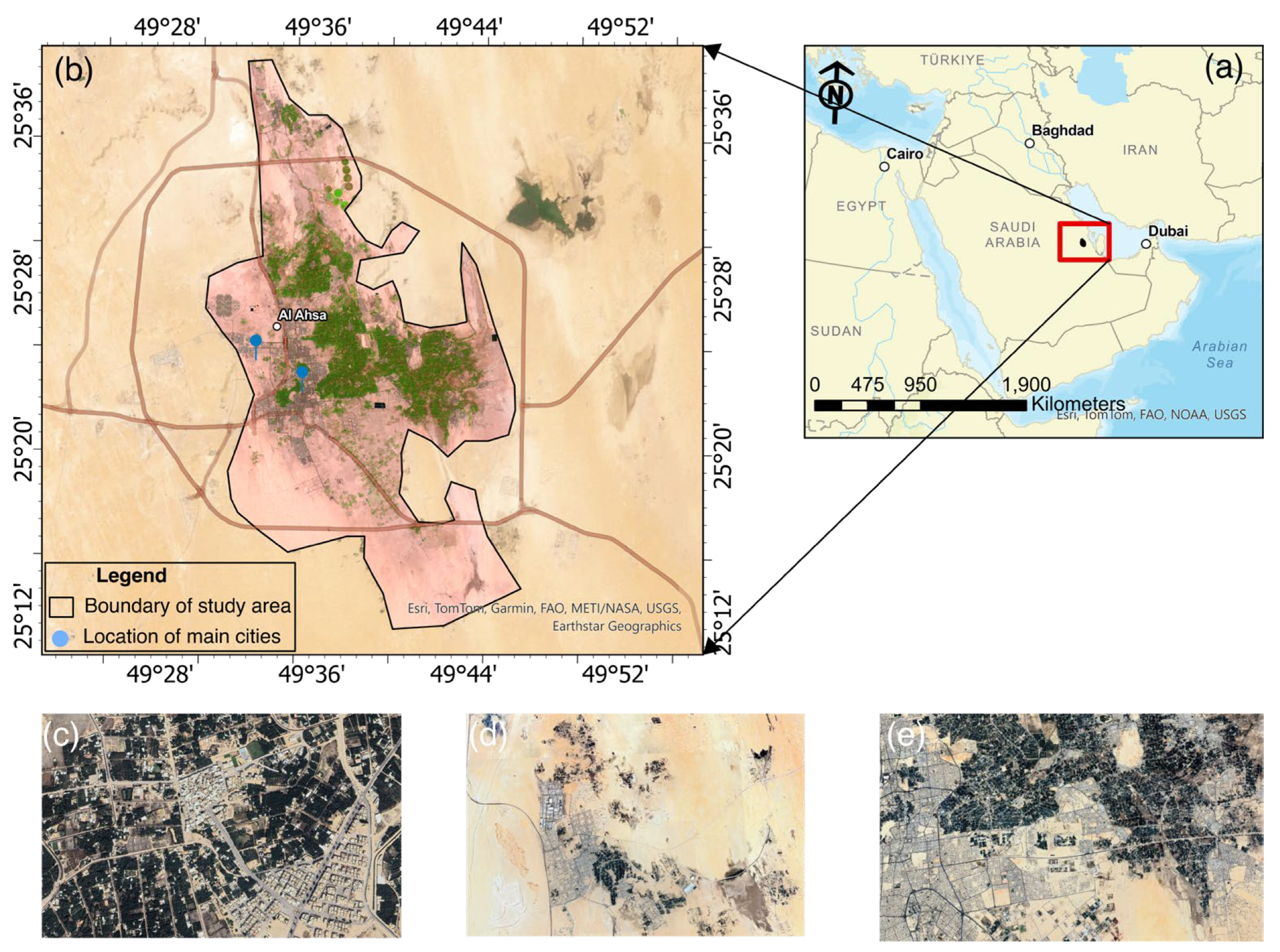

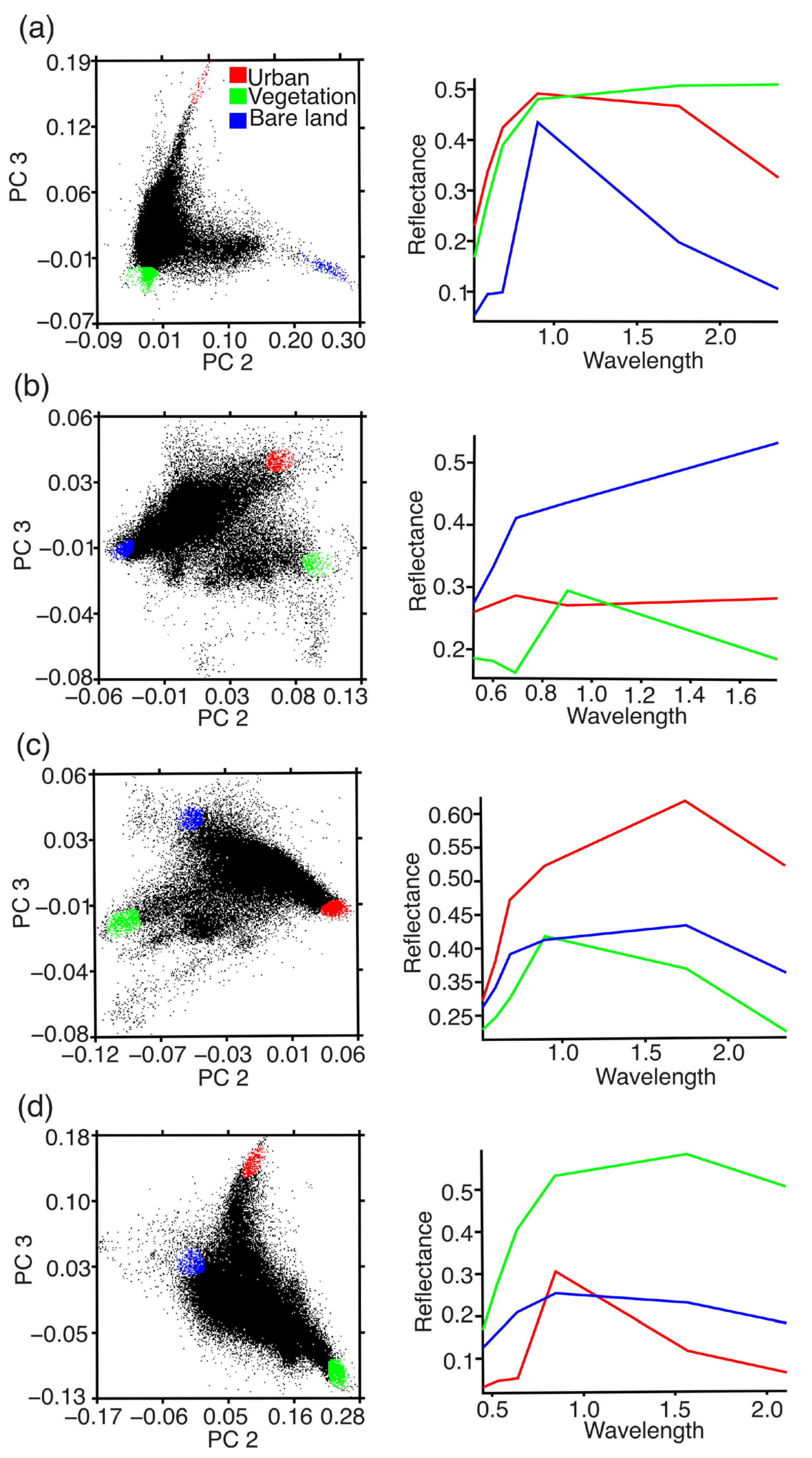
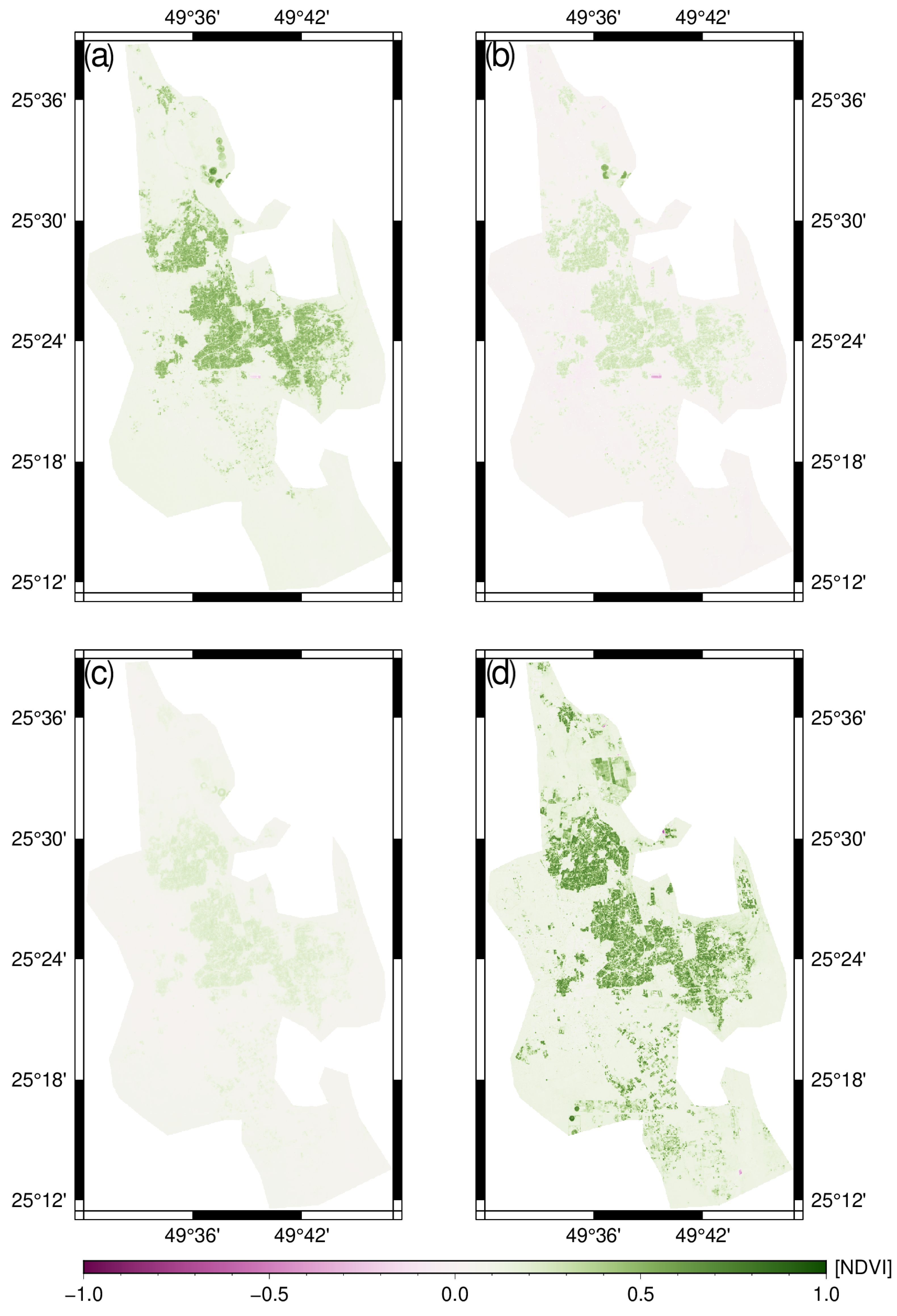
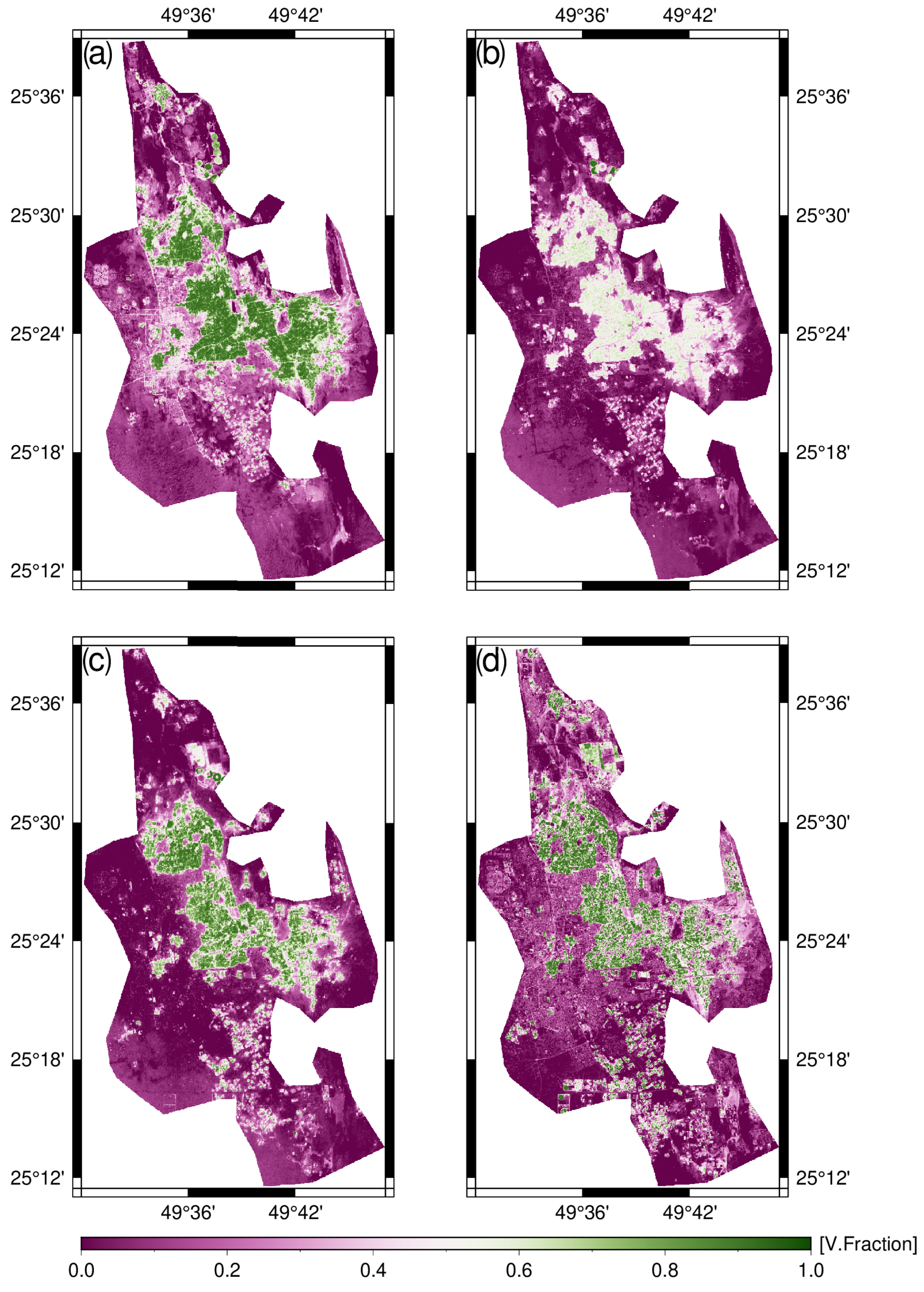

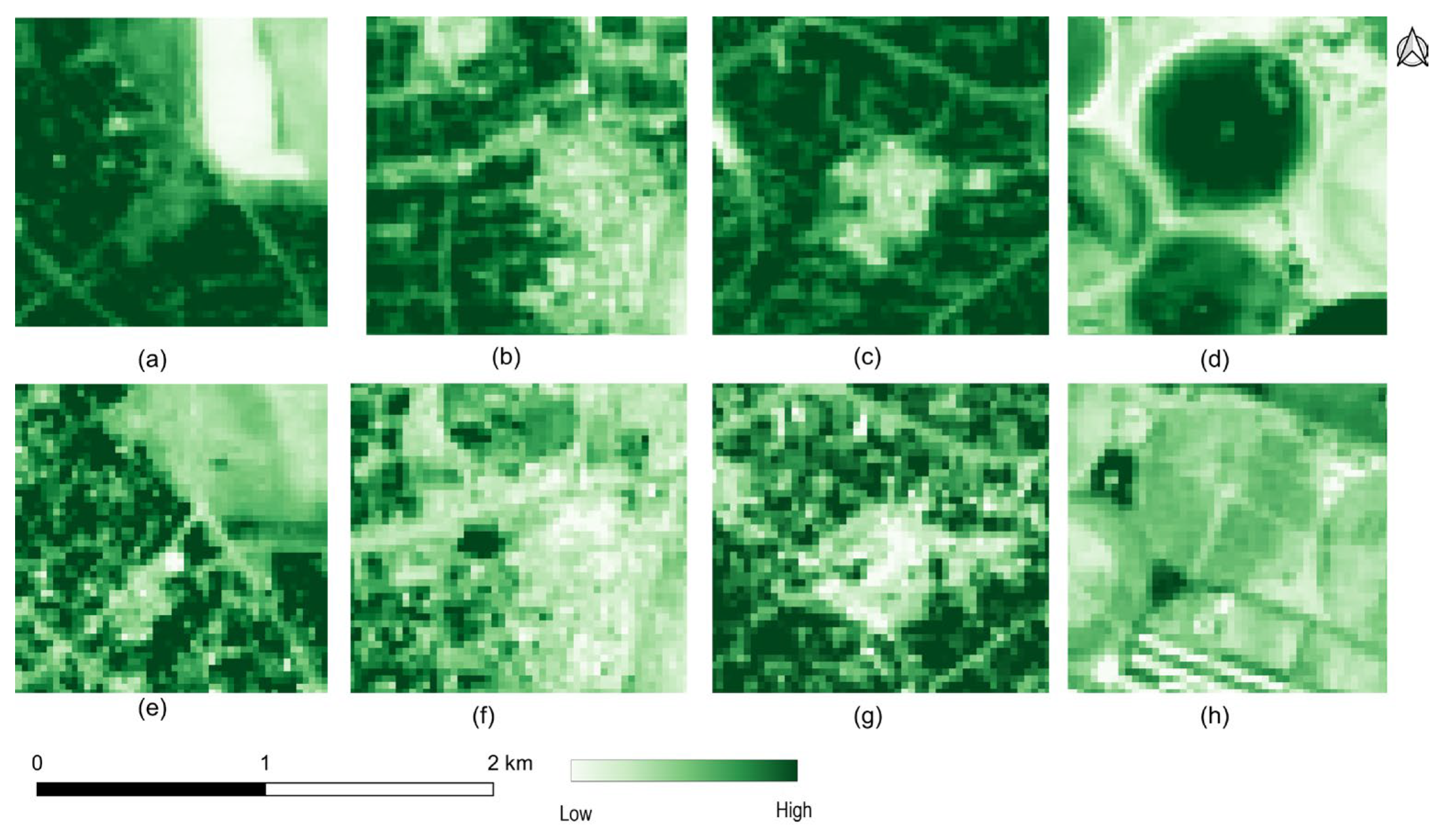
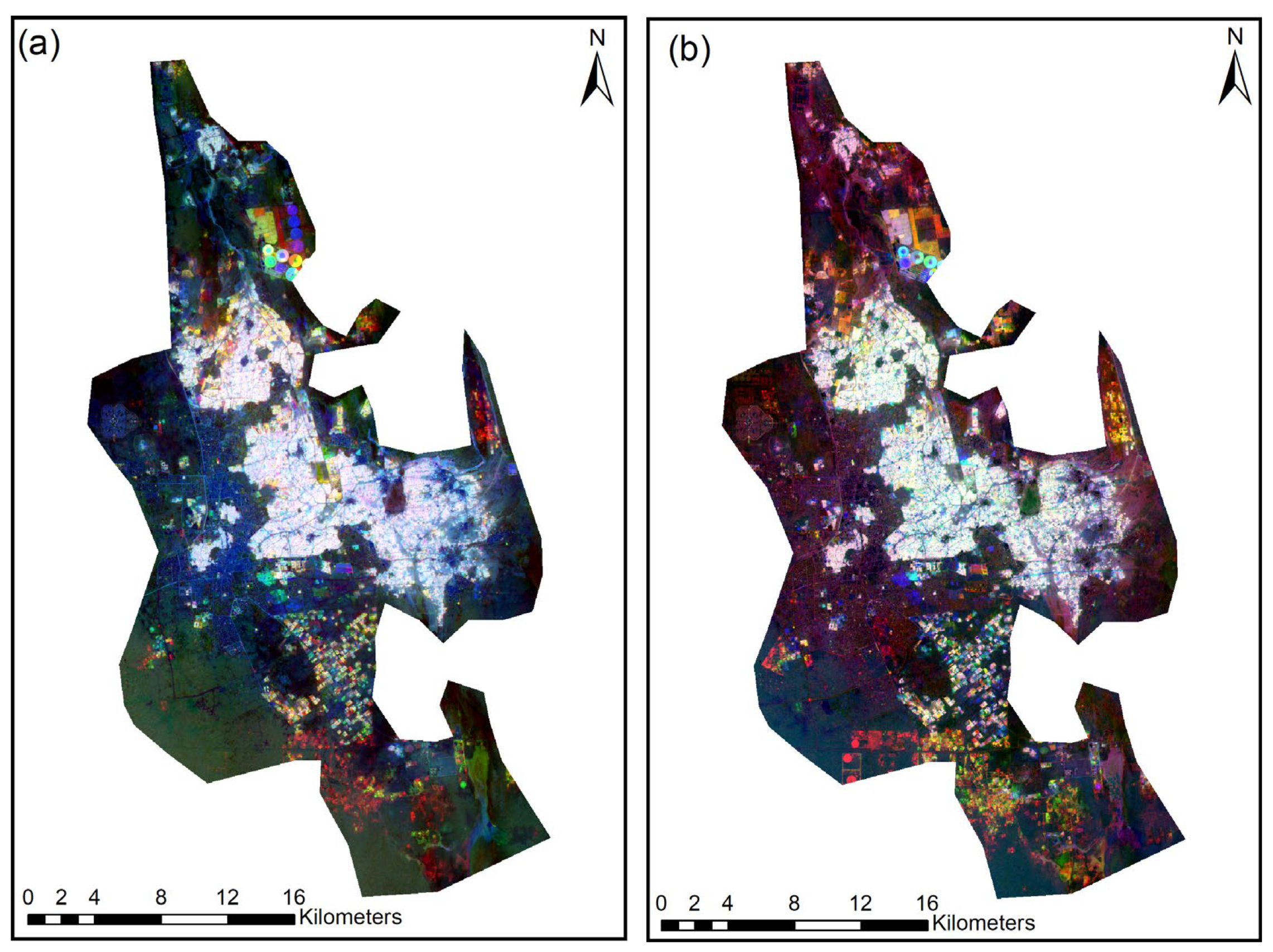
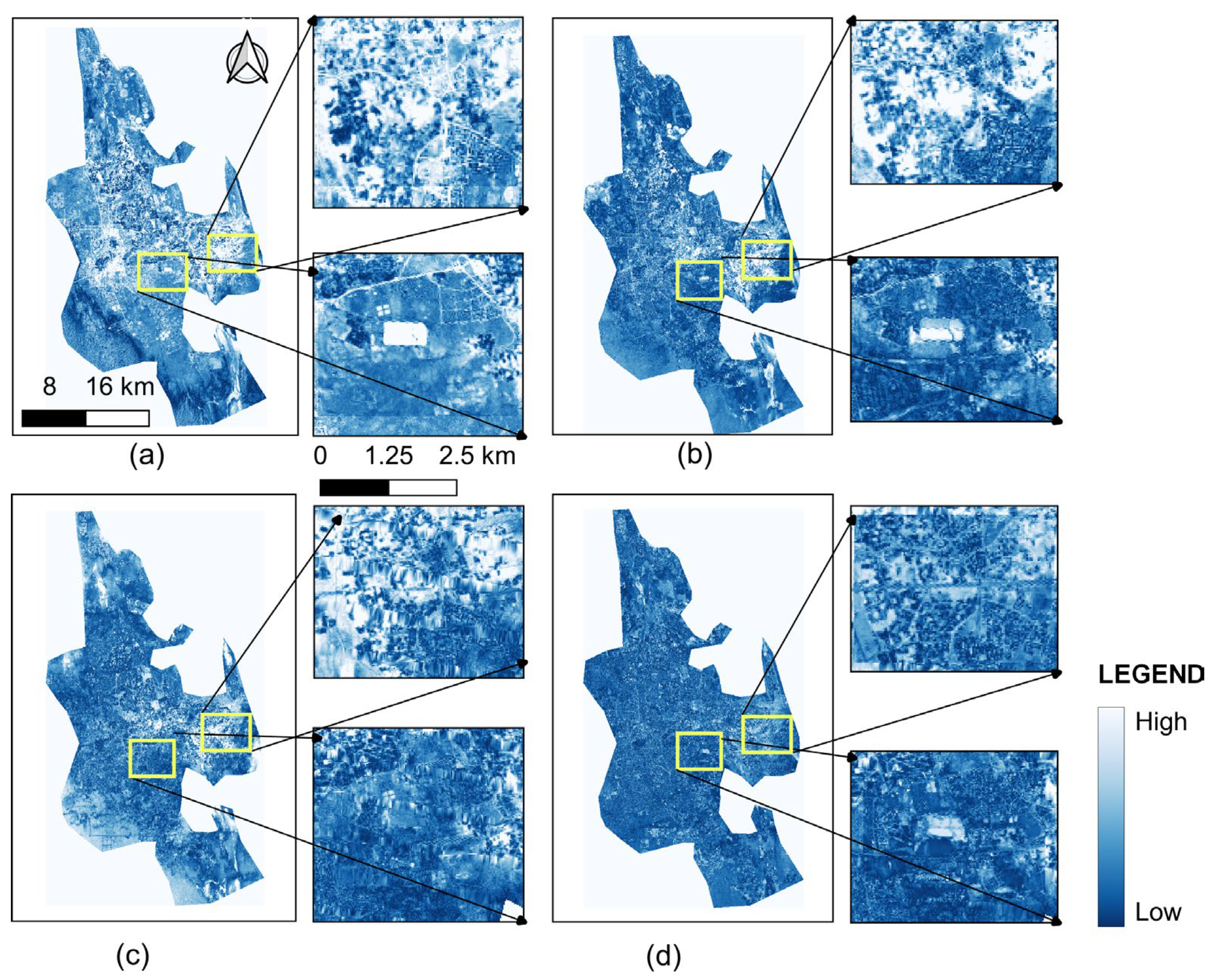
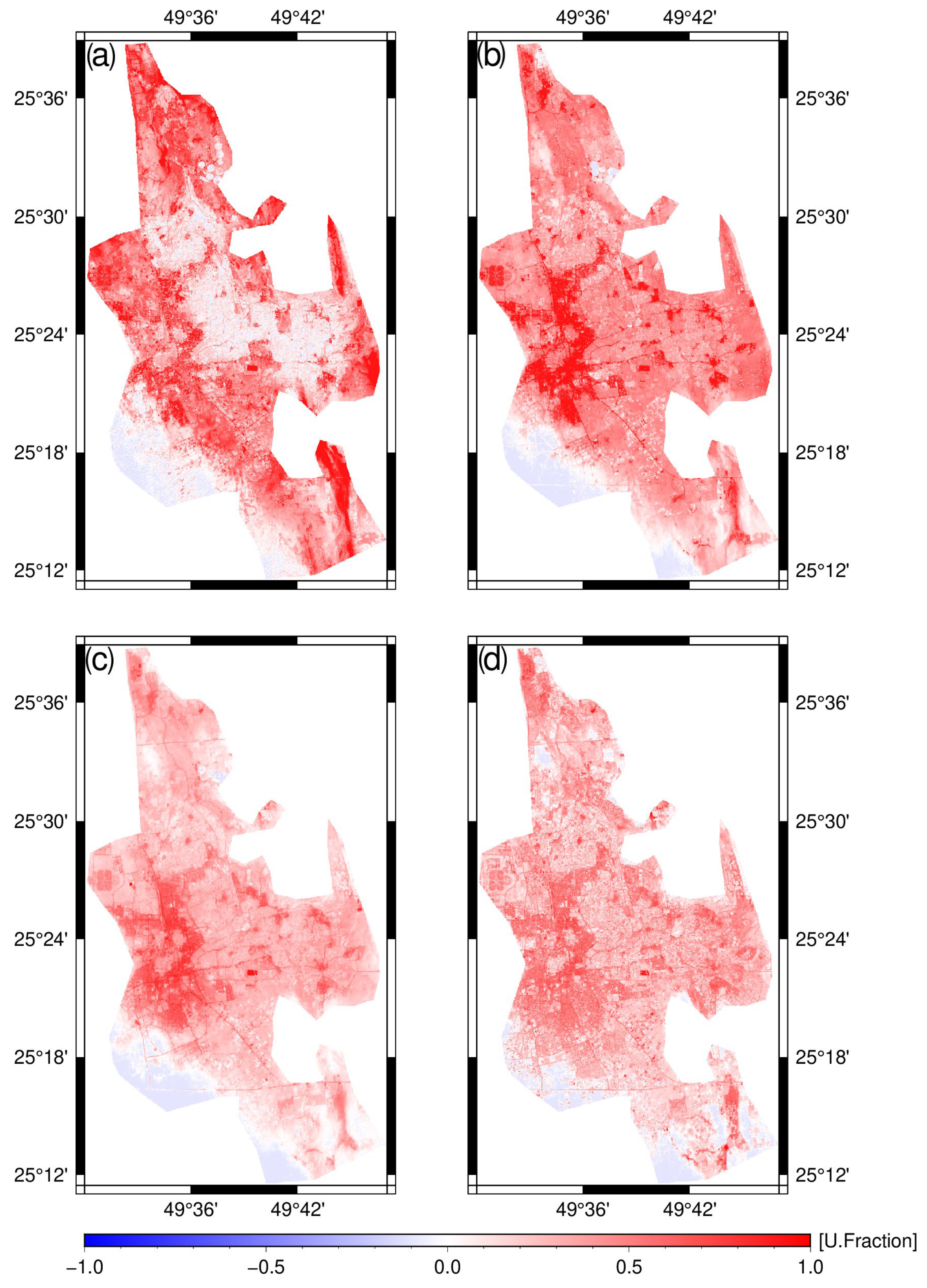
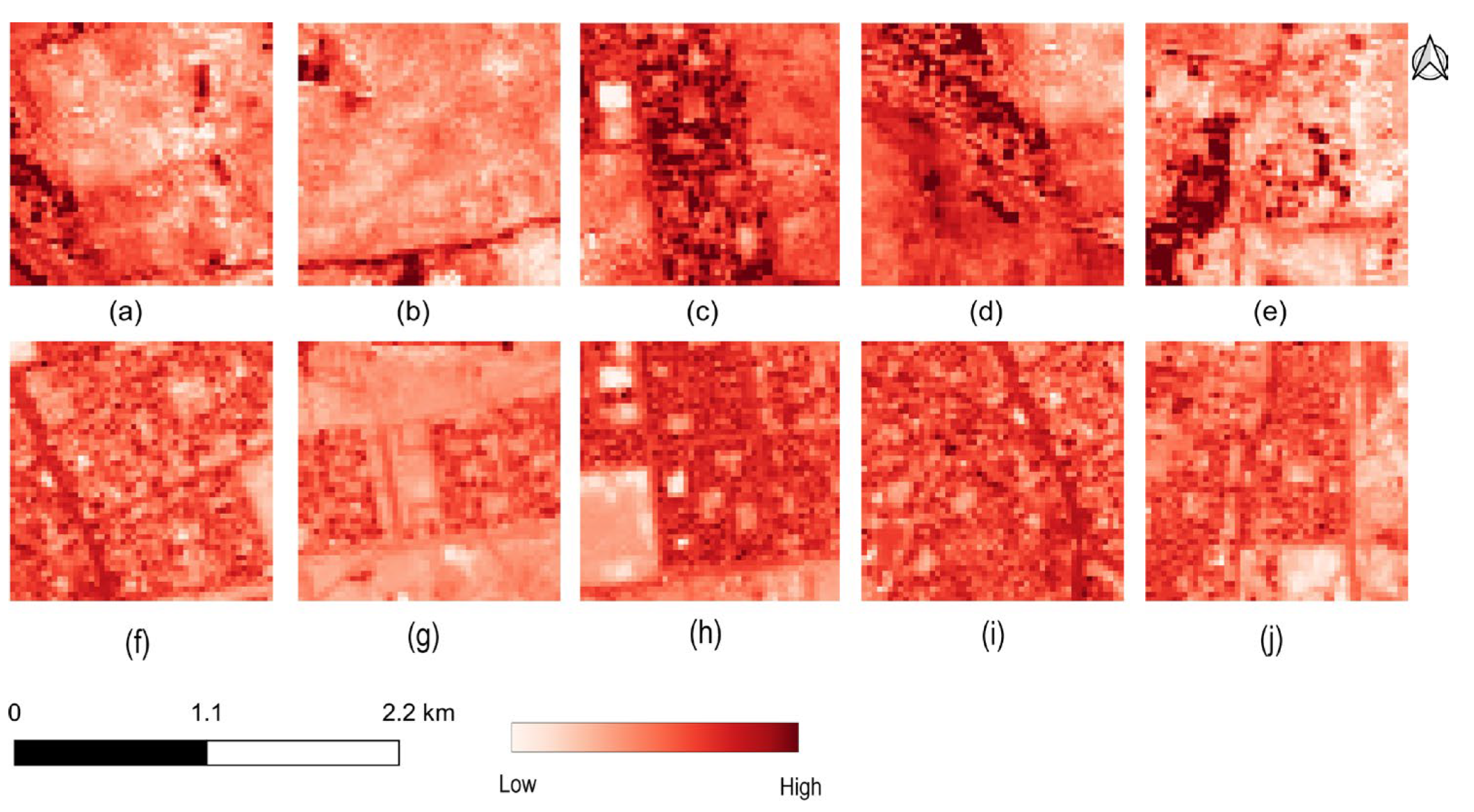
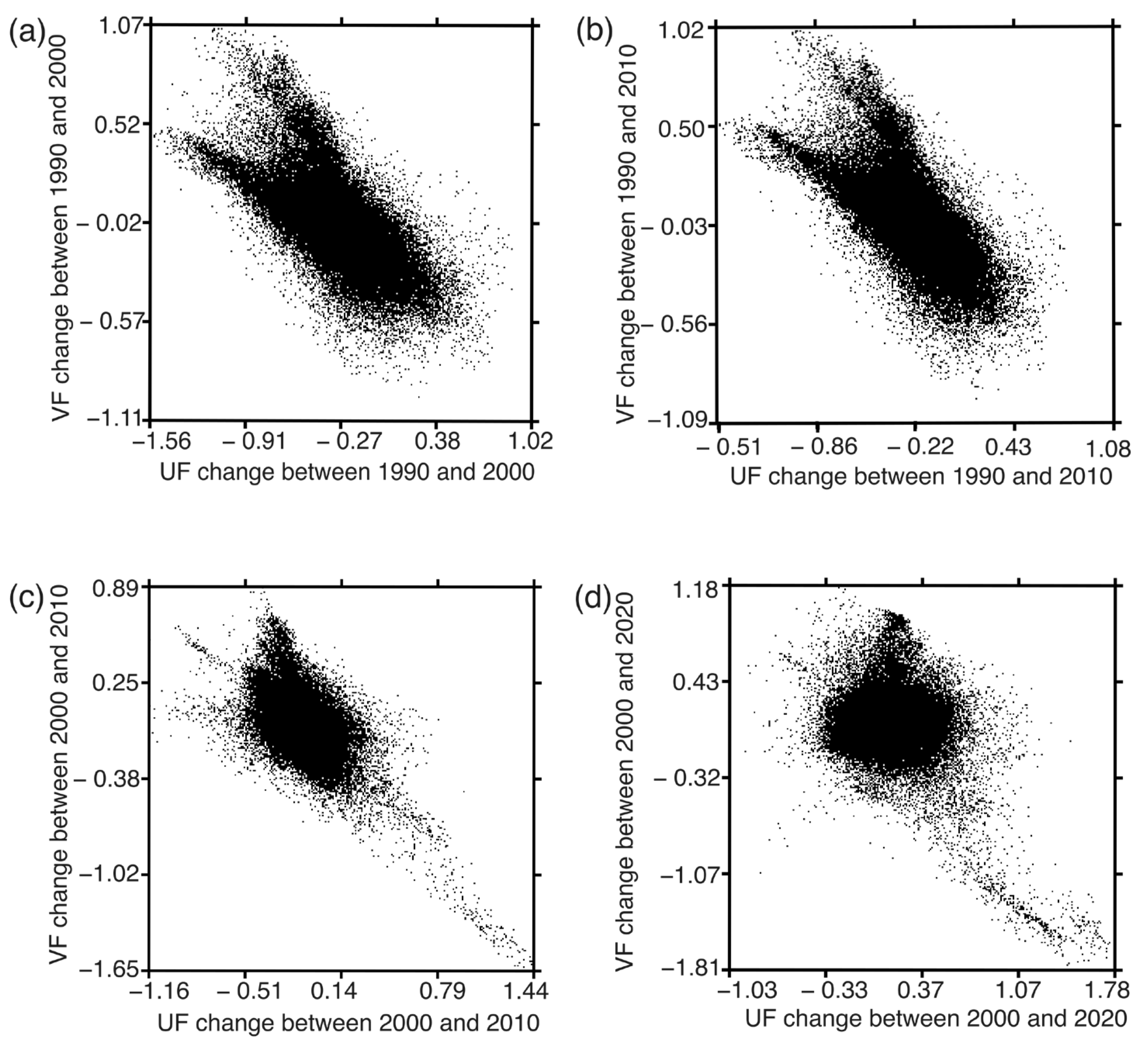
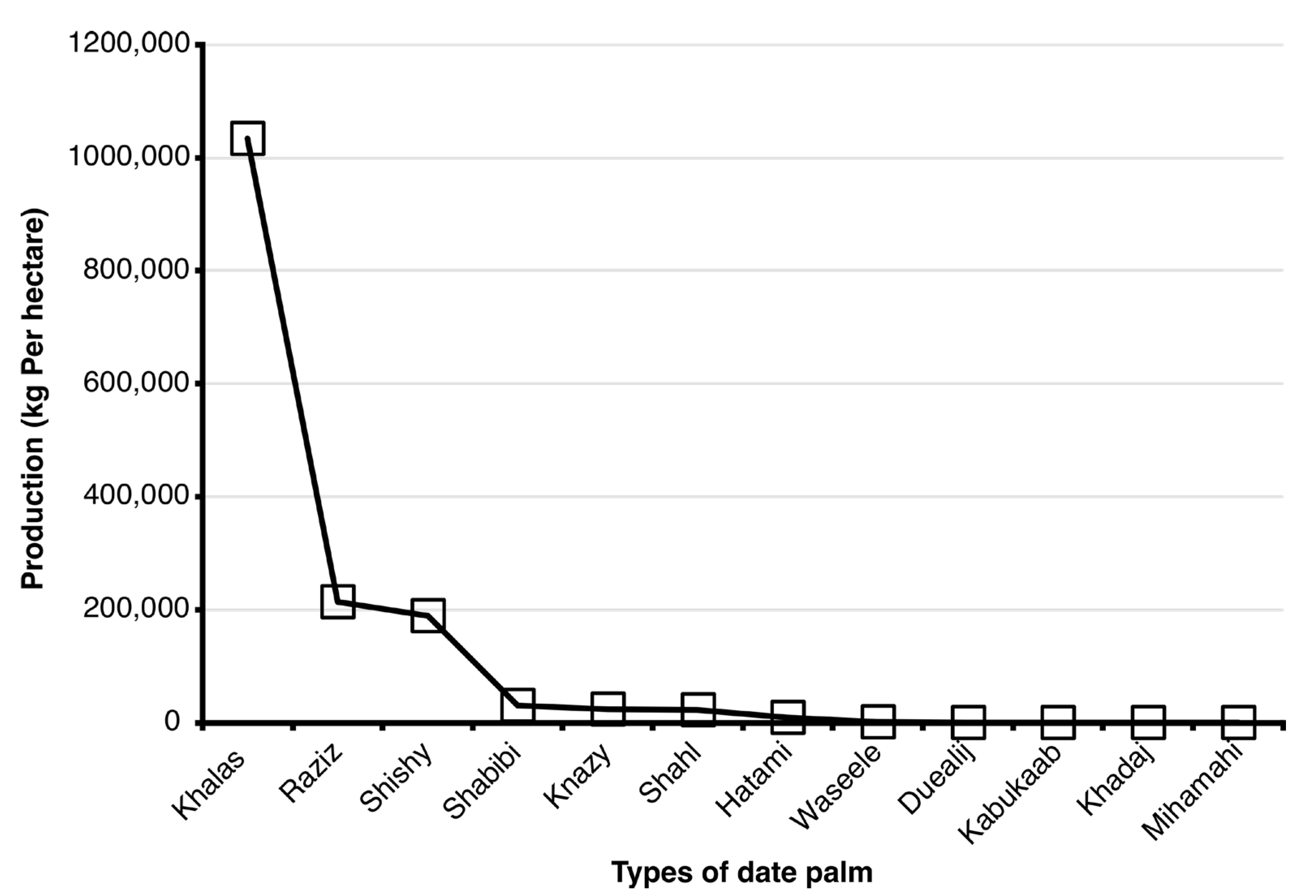
| Acquisition Date | Sensor/Source | Satellite | No. of Bands | Spatial Resolution (m) |
|---|---|---|---|---|
| 15 July 1990 | TM | Landsat 5 | 6 (optical), 1 (thermal) | 30 m (optical), 120 m (thermal) |
| 2 July 2000 | ETM+ | Landsat 7 | 6 (optical), 2 (thermal) | |
| 14 July 2010 | ETM+ | Landsat 7 | 6 (optical), 2 (thermal) | |
| 17 July 2020 | OLI and TIRS | Landsat 8 | 8 (optical), 2 (thermal) | 30 m (optical), 100 m (thermal) |
| 10 February 2025 | Google Earth Pro | GeoEye-1 | RGB | 1 m |
| 10 July 2015 and 19 July 2020 | MSI | Sentinel 2A | 1 (coastal aerosol), 3 (red edge), and 7 (optical) | 10–60 m |
| Times | RMS Residual Value (%) |
|---|---|
| 1990 | 0.048 |
| 2000 | 0.044 |
| 2010 | 0.051 |
| 2020 | 0.035 |
| 1990 | 2000 | 2010 | 2020 | |||||
|---|---|---|---|---|---|---|---|---|
| UA% | PA% | UA% | PA% | UA% | PA% | UA% | PA% | |
| Vegetation Fractions | 98.6 | 100 | 98.6 | 97.2 | 97.26 | 98.61 | 97.30 | 100 |
| Urban fractions | 100 | 98.6 | 100 | 98.6 | 98.59 | 97.22 | 100 | 97.22 |
| Overall Accuracy (OA) | 0.992 | 0.979 | 0.979 | 0.986 | ||||
| Year | Population Total | Rate of Increase (%) |
|---|---|---|
| 1992 | 444,970 | 0 |
| 2004 | 572,908 | 28.8 |
| 2010 | 660,788 | 14.8 |
| 2016 | 768,000 | 16.2 |
Disclaimer/Publisher’s Note: The statements, opinions and data contained in all publications are solely those of the individual author(s) and contributor(s) and not of MDPI and/or the editor(s). MDPI and/or the editor(s) disclaim responsibility for any injury to people or property resulting from any ideas, methods, instructions or products referred to in the content. |
© 2025 by the authors. Licensee MDPI, Basel, Switzerland. This article is an open access article distributed under the terms and conditions of the Creative Commons Attribution (CC BY) license (https://creativecommons.org/licenses/by/4.0/).
Share and Cite
Salih, A.; Hassaballa, A.; Rahma, A.E. Satellite-Derived Multi-Temporal Palm Trees and Urban Cover Changes to Understand Drivers of Changes in Agroecosystem in Al-Ahsa Oasis Using a Spectral Mixture Analysis (SMA) Model. Agriculture 2025, 15, 2043. https://doi.org/10.3390/agriculture15192043
Salih A, Hassaballa A, Rahma AE. Satellite-Derived Multi-Temporal Palm Trees and Urban Cover Changes to Understand Drivers of Changes in Agroecosystem in Al-Ahsa Oasis Using a Spectral Mixture Analysis (SMA) Model. Agriculture. 2025; 15(19):2043. https://doi.org/10.3390/agriculture15192043
Chicago/Turabian StyleSalih, Abdelrahim, Abdalhaleem Hassaballa, and Abbas E. Rahma. 2025. "Satellite-Derived Multi-Temporal Palm Trees and Urban Cover Changes to Understand Drivers of Changes in Agroecosystem in Al-Ahsa Oasis Using a Spectral Mixture Analysis (SMA) Model" Agriculture 15, no. 19: 2043. https://doi.org/10.3390/agriculture15192043
APA StyleSalih, A., Hassaballa, A., & Rahma, A. E. (2025). Satellite-Derived Multi-Temporal Palm Trees and Urban Cover Changes to Understand Drivers of Changes in Agroecosystem in Al-Ahsa Oasis Using a Spectral Mixture Analysis (SMA) Model. Agriculture, 15(19), 2043. https://doi.org/10.3390/agriculture15192043







